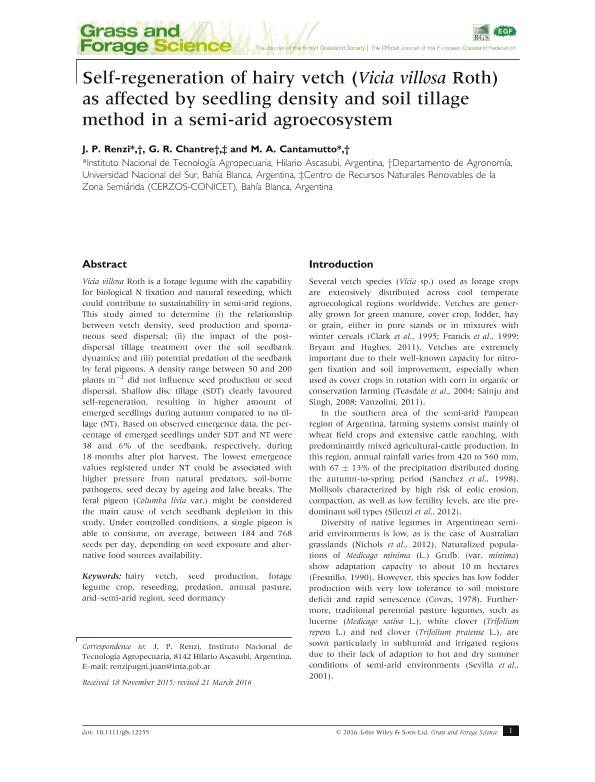Mostrar el registro sencillo del ítem
dc.contributor.author
Renzi, Juan Pablo

dc.contributor.author
Chantre Balacca, Guillermo Ruben

dc.contributor.author
Cantamutto, Miguel Ángel

dc.date.available
2017-10-23T19:43:20Z
dc.date.issued
2017-09
dc.identifier.citation
Renzi, Juan Pablo; Chantre Balacca, Guillermo Ruben; Cantamutto, Miguel Ángel; Self-regeneration of hairy vetch (Vicia villosa Roth) as affected by seedling density and soil tillage method in a semi-arid agroecosystem; Wiley; Grass and Forage Science; 72; 3; 9-2017; 524-533
dc.identifier.issn
0142-5242
dc.identifier.uri
http://hdl.handle.net/11336/26941
dc.description.abstract
Vicia villosa Roth is a forage legume with the capability for N biological fixation and natural reseeding, which could contribute to the sustainability in semi-arid regions. The present study aimed to determine (i) the relationship between vetch density, seed production and spontaneous seed dispersal; (ii) the impact of the post dispersal tillage treatment over the soil seedbank dynamics; and (iii) potential predation of seedbank by pigeons. A density range between 50 and 200 plants m-2 did not influence seed production or seed dispersal. Shallow disk tillage (SDT) clearly favoured self-regeneration, resulting in higher amount of emerged seedlings during autumn compared to no-tillage (NT). Based on observed emergence data, the percentage of emerged seedlings under SDT and NT were 38 and 6% of the seedbank, respectively, during 18 months after plot harvest. The lowest emergence values registered under NT could be associated to a higher pressure of natural predators, soil-borne pathogens, seed decay by ageing and false breaks. The feral pigeon (Columba livia var.) might be considered the main cause of vetch seedbank depletion in the present study. Under controlled conditions, a single pigeon is able to consume, in average, between 184 and 768 seeds per day, depending of seed exposure and alternative food sources availability.
dc.format
application/pdf
dc.language.iso
eng
dc.publisher
Wiley

dc.rights
info:eu-repo/semantics/openAccess
dc.rights.uri
https://creativecommons.org/licenses/by-nc-sa/2.5/ar/
dc.subject
Hairy Vetch
dc.subject
Seed Production
dc.subject
Forage Legume Crop
dc.subject
Reseeding
dc.subject
Predation
dc.subject
Annual Pasture
dc.subject
Arid-Semiarid Region
dc.subject
Seed Dormancy
dc.subject.classification
Otras Agricultura, Silvicultura y Pesca

dc.subject.classification
Agricultura, Silvicultura y Pesca

dc.subject.classification
CIENCIAS AGRÍCOLAS

dc.title
Self-regeneration of hairy vetch (Vicia villosa Roth) as affected by seedling density and soil tillage method in a semi-arid agroecosystem
dc.type
info:eu-repo/semantics/article
dc.type
info:ar-repo/semantics/artículo
dc.type
info:eu-repo/semantics/publishedVersion
dc.date.updated
2017-10-09T15:31:53Z
dc.journal.volume
72
dc.journal.number
3
dc.journal.pagination
524-533
dc.journal.pais
Estados Unidos

dc.journal.ciudad
Hoboken
dc.description.fil
Fil: Renzi, Juan Pablo. Instituto Nacional de Tecnología Agropecuaria. Centro Regional Buenos Aires Sur. Estación Experimental Agropecuaria Hilario Ascasubi; Argentina
dc.description.fil
Fil: Chantre Balacca, Guillermo Ruben. Consejo Nacional de Investigaciones Científicas y Técnicas. Centro Científico Tecnológico Conicet - Bahía Blanca. Centro de Recursos Naturales Renovables de la Zona Semiárida. Universidad Nacional del Sur. Centro de Recursos Naturales Renovables de la Zona Semiárida; Argentina
dc.description.fil
Fil: Cantamutto, Miguel Ángel. Instituto Nacional de Tecnología Agropecuaria. Centro Regional Buenos Aires Sur. Estación Experimental Agropecuaria Hilario Ascasubi; Argentina
dc.journal.title
Grass and Forage Science

dc.relation.alternativeid
info:eu-repo/semantics/altIdentifier/doi/http://dx.doi.org/10.1111/gfs.12255
dc.relation.alternativeid
info:eu-repo/semantics/altIdentifier/url/http://onlinelibrary.wiley.com/doi/10.1111/gfs.12255/abstract
Archivos asociados
